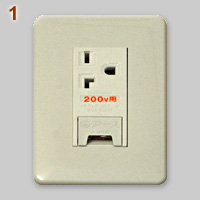 |
Japan Heavy duty plugs and sockets |
 |
Japan Heavy duty plugs and sockets |
| Japan
has a 100V network. Standard, domestic plugs and sockets are
essentially
identical to North American NEMA 1-15 and 5-15. Most plugs and
sockets for higher currents and voltages are similar to North American
NEMA configurations, but some are different (notably
locking types). Examples of heavy duty single phase, split-phase or three-phase
devices are shown below. Note that the domestic voltage in Japan in 100V, but there are two network systems that differ with respect to frequency. The first generator was installed in 1895 in Tokyo by the German company AEG (50Hz). A year later the U.S. company General Electric installed a 60Hz generator in Osaka. Still today, the northeastern part of the country has 50Hz, while the southwestern part has 60Hz. |
 |
 |
 |
 |
 |
 |
 |

|
| 1 | Japanese 200V, 15-20A single phase socket. The right hand, U-shaped slot is the earth connection. In addition there is also a connector - hidden behind the flap below the outlet - for a ground adapter (see type A/B domestic plugs, item 6). 200V originates from a 208V nominal voltage system, which means 208V at the point of supply and an utilization voltage of 200V 'at home'. Usually there is a 3-5% voltage drop in transport lines from transformer station to residence. See scheme of Y-transformer below. Brand name: National (Panasonic). Image no. 5 shows a matching 15A plug. {WaO} |
| 2, 3 | 3-phase, earthed socket and plug, rated at 15A-250V. To wire up the plug you simply have to lift up the brown, circular base plate. The scheme of a 3-phase, Y-connected transformer (at the bottom of the page) shows the wiring of this type of plugs. Brand name of both socket and plug: Meikōsha, Tokyo, Japan. {WaO} |
| 4 | Plug similar to no. 3, but rated at
20A-250V. Plugs no. 3 and
4 are depicted in the same scale. Models are idential to respectively
NEMA 18-15P and 18-20P. Brand name: Meikōsha. {FSE} |
| 5 |
Socket and plug rated at 15A-250V. The
schemes show the difference between a 15A and 20A
250V plug. Corresponding, but not earthed sockets and plug are shown in image nos. 6, 7 and 8. Manufacturer: Meikōsha. {FSE} |
| 6 | Not earthed, 2-pin 15A-250V plug. Manufacturer: the M logo and M.K.S refer to.Meikōsha. {FSE} |
| 7 |
Not earthed, 2-pin 20A-250V socket and plug. Models are identical to NEMA 2-20R/P (see North American heavy duty page). Manufacturer: National (Panasonic). {FSE} |
| 8 | Not earthed, 2-pin 20A-250V plug. Socket no. 7 and plug no.8 are identical to NEMA 2-20R/P (see North American heavy duty page). Manufacturer: Meikōsha. {FSE} |
 |

|
 |
 |
 |
 |
 |
| 9 | Classic
type 3-phase 5-wire socket (L1, L2, L3, N and ground) for straight
blade plugs. Rating is unknown, but 15 or 20 Amp - 250V seems likely.
Nowadays 5-wire sockets are always twist lock types (system comparable
to images 11 -14). Shown socket is not part of the collection, but based on a photo taken by Jhon Zeng. If somebody knows details (dating, rating, use etc.} please contact me; see home page for mail address. |
| 10a | Plug
rated at 15A-250V. Pin size and orientation are identical to the
standard 10A Australasian plug. None of the pins has an indication with
respect to wiring. It seems likely that it is a split-phase plug,
comparable to the 20A version (see no. 10). A comparable NEMA configuration does not exist, but the Japanese plug is identical to an outdated U.S. 15A-125V / 10A-250V single phase model (see page on North American classic plugs and sockets). Brand name: Meikōsha. {FSE} |
| 10b | Unearthed 20A-250V split-phase
plug. W-pole + one of the angled poles = 120V. Both angled poles =
208V, see scheme below. Model identical to NEMA 10-20P (see North
American dual voltage page). Brand name: Meikōsha. {FSE} |
| 11, 12 |
Locking
type 20A-250V single
phase socket and plug. To wire up the plug you have to lift up the
white base plate. A different shape of the earth pin makes the Japanese model incompatible with NEMA L6-20. Brand name: Meikōsha. {WaO} |
| 13, 14 | Locking type 20A-250V four wire (3-phase +
earth) outlet and plug. The model differs from any of the NEMA 3P, 4W
configurations. Brand name: Meikōsha. {FS} |
 |
 |
| Split-phase
wiring offers both single
phase 125V and 250V. To achieve this the output coil of the transformer
is center-tapped (red dot in the scheme) and connected to
neutral. X-W (neutral) as well as Y-W = 125V. Because of alternating current the two line poles are out of phase, therefore X-Y = 250V |
The
secondary coil of a 3-phase
Y-connected transformer
has four conductors. In the example shown there is 208 Volt between two
phases (1-2, or 1-3, or 2-3). Between the neutral connector and one of
the phases there is 120 Volt (= 208 / √3). Note that in both schemes given voltages are nominal voltages that are dependent of the voltage at the input side of the transformer. |
| |
D i g i t a l M u s e u m o f | |
P l u g s a n d S o c k e t s | |